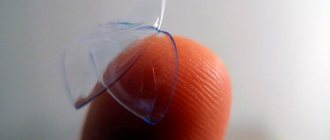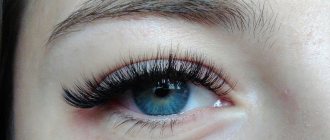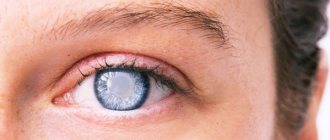Today, many people can use a variety of contact lenses instead of glasses. Sometimes many people may face a problem where the lens does not stick to the eye.
Why does the lens not stick to the eye?
In most cases, this problem occurs among beginners who do not yet know how to use lenses correctly. In this article we will tell you the reasons why the lens does not stick to the eye.
Reason #1. The lens doesn't stick because it's turned inside out
This problem is considered the most common, since even if a person has been using contact lenses for a long time, he can still wear an inverted lens. To determine what position the lens is in, place it on the tip of your finger. If you see the numbers that are depicted on it in the correct sequence, then you can be sure that everything is fine. If the numbers are reversed, then this means that the lens is inverted.
The numbers on the lens will help you understand whether the lens is inverted or not.
This is what an inverted and correct lens looks like
The lens is inside out
This is the most common case. Why is this happening? Most often this happens due to improper removal, when a person turns the lens out in the evening and places it in the same form in a special container overnight. Then in the morning, without hesitation, he puts it on as usual.
How can you tell if a lens is on the right side or is it inside out? To do this, you need to place it on your finger and carefully examine it. Even if the lens has a convex shape, its edges may be slightly concave inward. This means it's turned inside out. Also, when you place the lens on your finger, you can see barely noticeable numbers on it. They may be different for different manufacturers. If the product is positioned correctly, then the numbers will be turned towards the person with the right side (readable), otherwise they will be inside out. This is created by manufacturers specifically for such cases when there are doubts about the coating before putting it on.
Such cases are most typical for modern products made from hydrogel material. These optical correction devices are thinner, and therefore the likelihood of them being everted is much higher.
Reason #2. Incorrect selection or defect
If you encounter a similar problem, then you need to contact the store where you made the purchase.
It is important to know! To understand that a lens is truly defective, it is best to consult a doctor who will confirm this fact.
Sometimes the reason may be considered to be a factory defect of the lens.
You also need to remember that it is best to give your attention to models that have high humidity.
For what reasons does the lens slip off the eye?
Precisely fitted contact lenses improve vision and are almost invisible to the eyes while worn. Problems arise if the lens parameters are chosen incorrectly. At the same time, it can move from the cornea and cause a feeling of discomfort.
Correction with contact lenses allows you to quickly correct your vision. They are effective in combating astigmatism (blurred vision at any distance to an object) and farsightedness. With the help of hard lenses, myopia and keratoconus (non-spherical shape of the cornea) are treated. In some cases, contact optics for therapeutic purposes may be prescribed to a child up to one year old.
Thematic forums often discuss the selection and effective care of contact correction products. To make their use as comfortable as possible, when selecting them, you should consult an ophthalmologist. The doctor will conduct an examination using special equipment and write a prescription for contact lenses indicating their optical power, diameter and the radius of curvature you need. A properly fitted lens is easy to put on and take off, with enough grip on the eye to prevent it from shifting.
When answering the question about the reasons for contact optics slipping, experts identify two main ones:
1. If its radius is greater than the radius of the cornea, then it simply will not “sit” on the eye. At the same time, during the process of blinking or when moving the gaze from side to side, there is a possibility of displacement. The lens can move under the eyelid, causing discomfort, pain in the eyes and excessive tearing. In this case, you must remove it with clean hands and consult a doctor to check your vision parameters. Standard radii of curvature range from 7.8 cm to 9.5 cm. Modern equipment makes it possible to produce custom-made contact optics with different parameters. Thus, the opportunity to use contact correction devices has also appeared for those patients who previously had to rely only on constant wearing of glasses.
2. A contact lens placed on the wrong side can “float” in the eye. Turned inside out, it looks like a plate with flat edges; in the correct position it has the shape of a spherical bowl. Before you start using, make sure that it has the correct geometry, then moisten it with a few drops of a multifunctional solution and put it on. Even if it was not possible to determine the right side the first time, the lens can be removed, turned out, washed with a solution and put on again.
The reason may also be a manufacturing defect, but in any case, if difficulties arise when using contact correction means, the help of a specialist is required.
Reason #4. Violation of operating rules
Many experts also highlight certain rules that should never be broken. These include:
- If you purchased a soft lens model, then remember that they cannot be treated with a solution intended for hard lenses.
- Once the lenses are placed in the container, coat the lenses with the solution.
- A multi-purpose solution cannot be used twice.
Do not use multi-purpose solution twice
If the lens has been left without solution for a long enough time, then you can throw it away.
Removing a contact lens
— Always wash your hands before removing contact lenses. If you remove contact lenses over a sink, cover the sink drain with a clean, lint-free towel to prevent a contact lens you accidentally drop from getting in.
— To remove a contact lens, look up or to the side while pulling down your lower eyelid with your middle finger. Using the fingertip of your other hand, gently slide the contact lens down or to the side (on the white part of your eye). Gently grasp the contact lens with your index finger and thumb (the pads of your fingers, not your nails) and remove it from your eye.
— After performing your normal daily contact lens care routine, store your contact lenses in their case until the next time you wear them.
ADVICE:
If the contact lens sticks together after removal, do not try to straighten it by pulling at the edges - this could cause you to tear it. Place the contact lens in the container with the solution, and most likely the contact lens will straighten itself there. If this does not happen, gently rub it between your thumb and forefinger, after moistening it well with the solution.
What to do if the lens sticks to your finger
Sometimes you may encounter a problem where the lens does not stick to the eye due to the fact that it is glued to the finger. In most cases, a similar problem can occur in people who have not yet trained. Solving such a problem will be quite simple. You will need to place a few drops of lens solution inside the product to keep your finger dry. You can then install the lens into your eye.
If the lens does not stick to your eye, then you may not have enough experience
If you do everything correctly, then remember that in this case the lens will not stick to your finger, but will be able to fit correctly on the iris.
Main reasons
Material
Much depends on the material from which the lenses are made. If it is a hydrogel, then it contains a lot of moisture and such lenses feel very soft. It can turn out on your finger and therefore not stick to your eye.
Silicone hydrogel lenses are more comfortable to wear. They feel denser to the touch and are therefore easier to handle. But again, it all depends on the characteristics of your eyes.
Therefore, do not be lazy to go and consult a doctor. He will select lenses for you that your eyes will quickly get used to. This will make them easier to use in the future.
Experience using lenses
The technique of putting on lenses plays a big role. Often, out of habit, a person blinks before the lens comes into contact with the surface of the eye. Because of this, it does not stick. Hold your upper eyelid to prevent this from happening.
Many people need about a month to get used to it. Further, this process takes no more than five seconds. Those who have only recently started wearing lenses begin to blink frequently before putting them on. Because of this, more tears are produced, which makes it difficult to put on the lenses properly.
This is because many people become very nervous during this process. But you shouldn’t do this, because if you follow all the instructions for putting on lenses, you can easily attach them to your eye.
Lens selection
If the lenses are chosen incorrectly, they will often not fit your eyes. Some people buy lenses without a doctor's recommendation, and therefore choose them incorrectly. After all, you can make a mistake with the size and the lens will either fall out or stick too much, creating discomfort.
Also, the feeling of sand after wearing contact lenses for many hours can also indicate incorrectly selected lenses.
Misuse
Lenses, like any other thing, have rules of use, and in this case it is strictly forbidden to violate them. It is forbidden to clean lenses with a medical solution if the lenses themselves are soft, and the solution is for hard ones.
The container should not be washed in plain tap water. The solution cannot be used several times; change it. To understand all this in more detail, visit an ophthalmologist. He will advise you. In general, in everything related to medicine, it is advisable to consult with doctors so as not to harm yourself.
And it’s even more so with the eyes. After all, failure to comply with the simplest rules of hygiene when using the same contact lenses leads to infection. And this is far from fabulous. Therefore, take this extremely seriously.
Defective lens
No one rules out a manufacturing defect. Even if, after following all the rules and recommendations, your lenses do not stick to your eyes, they may be of poor quality. To solve this problem, contact the store where you purchased them.
Also try to use more well-known brands, reviews of which are easy to find on the Internet.
Damage
Check the lens carefully for damage. If they are, then under no circumstances should you use it. At the same time, try to touch nothing until the moment you need to put on the lens. You may get an infection, and the lens will also lose its ability to stick to your eye due to the presence of dirty particles and grease on it.
Lack of moisture
The lens should be slightly moistened. If it is dry, it simply cannot sit on the eye, and if it is too wet, it will slide across the surface of the eye.
Instructions for putting on
To avoid this problem, you need to follow the following recommendations:
- First you need to wash your hands thoroughly.
- Now you can place the lens on the tip of your finger and check if it is inside out. Now you can open your eye and place it on your eye.
- The product will need to be placed slightly below the pupil.
- You can now blink to get the lens into place.
If you wear lenses, then you should not rub your eyes.
Now you know how to put on a lens so that it does not stick to your eye. If you follow our instructions, then remember that the donning process will not be difficult at all.
Thanks to the video, you can get more detailed information on how to quickly put on lenses. We hope this information was useful and interesting.
What to do?
An overdried product, even if it sticks to the eye, cannot be worn, as this will cause scratches on the cornea and the development of an inflammatory process in the mucous membranes.
Before using the products, it is important to dry your hands after the preliminary hygiene procedure.
The algorithm of actions varies depending on the cause of the problem. If the rules of use have not been violated, and the plate is not turned out, then you should contact your ophthalmologist and pick up a new pair. To avoid problems with putting on the corrective device, you must follow the operating rules:
- Before putting it on, you must wash and dry your hands.
- You must apply the lens with your index finger, after making sure that the position is correct.
- To avoid blinking, you should gently pull your eyelids up and down.
- The plate is fixed in position under the pupil.
- Once installed, movements of the gaze up and down, followed by blinking are shown.
- Rubbing the organs of vision is prohibited.
If the problem arose due to the dryness of the record, which was left without liquid for a short time, you can try to soften it. The lens is placed in the solution for 5-6 hours, but ophthalmologists do not recommend such actions. Manipulation is applicable only as a temporary measure before purchasing new lenses. In case of increased dryness of the eye, it is necessary to instill moisturizing drops into the mucous membranes, first removing the optical devices - “Albucid” or “Vitabakt”. You can put the optical aids back on only after 10-15 minutes.
Incorrect use of the solution
A lens left without solution for a long time will deteriorate, so it should be thrown away. It is important to use saline solutions specially made for these devices, and not mixed at home.
Do not treat hard lenses with soft lens solution. After you have placed the products in a container with a special product, check that they are completely immersed. If the lens is poorly saturated with the solution, you should dip it into this liquid on both sides several times. After this, the optical device will stick if there are no other problems with it. Multi-purpose solution cannot be used twice.









